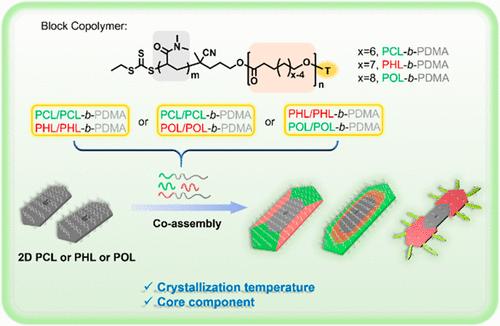当前位置:
X-MOL 学术
›
ACS Macro Lett.
›
论文详情
Our official English website, www.x-mol.net, welcomes your feedback! (Note: you will need to create a separate account there.)
Regulation of Two-Dimensional Platelet Micelles with Tunable Core Composition Distribution via Coassembly Seeded Growth Approach
ACS Macro Letters ( IF 5.1 ) Pub Date : 2024-04-17 , DOI: 10.1021/acsmacrolett.4c00124 Liping Liu 1 , Xiancheng Meng 1 , Meili Li 1 , Zhenyan Chu 1 , Zaizai Tong 1
ACS Macro Letters ( IF 5.1 ) Pub Date : 2024-04-17 , DOI: 10.1021/acsmacrolett.4c00124 Liping Liu 1 , Xiancheng Meng 1 , Meili Li 1 , Zhenyan Chu 1 , Zaizai Tong 1
Affiliation

|
Seeded growth termed “living” crystallization-driven self-assembly (CDSA) has been identified as a powerful method to create one- or two-dimensional nanoparticles. Epitaxial crystallization is usually regarded as the growth mechanism for the formation of uniform micelles. From this perspective, the unimer depositing rate is largely related to the crystallization temperature, which is a key factor to determine the crystallization rate and regulate the core composition distribution among nanoparticles. In the present work, the coassembly of two distinct crystallizable polymers is explored in detail in a one-pot seeded growth protocol. Results have shown that polylactone containing a larger number of methylene groups (−CH2−) in their repeating units such as poly(η-octalactone) (POL) has a faster crystallization rate compared to poly(ε-caprolactone) (PCL) with a smaller number of −CH2– at ambient temperature (25 °C), thus a block or blocky platelet structure with heterogeneous composition distribution is formed. In contrast, when the crystallization temperature decreases to 4 °C, the difference of crystallization rate between both cores become negligible. Consequently, a completely random component distribution within 2D platelets is observed. Moreover, we also reveal that the core component of seed micelles is also paramount for the coassembly seeded growth, and a unique structure of flower-like platelet micelle is created from the coassembly of PCL/POL using POL core-forming seeds. This study on the formation of platelet micelles by one-pot seeded growth using two crystallizable components offers a considerable scope for the design of 2D polymer nanomaterials with a controlled core component distribution.
中文翻译:

通过共组装种子生长方法调节具有可调核心成分分布的二维血小板胶束
被称为“活”结晶驱动自组装(CDSA)的种子生长已被认为是创建一维或二维纳米颗粒的有效方法。外延结晶通常被认为是形成均匀胶束的生长机制。从这个角度来看,单聚体沉积速率在很大程度上与结晶温度有关,结晶温度是决定结晶速率和调节纳米颗粒之间核心成分分布的关键因素。在目前的工作中,在一锅种子生长方案中详细探讨了两种不同可结晶聚合物的共组装。结果表明,与聚(ε-)相比,重复单元中含有大量亚甲基(-CH 2 -)的聚内酯(例如聚(η-八内酯)(POL))具有更快的结晶速率己内酯)(PCL)在环境温度(25℃)下具有较少数量的-CH 2 -,从而形成成分分布不均匀的块状或块状片状结构。相反,当结晶温度降低至4℃时,两个核之间的结晶速率差异可以忽略不计。因此,观察到二维血小板内完全随机的成分分布。此外,我们还发现,种子胶束的核心成分对于共组装种子的生长也至关重要,并且使用POL成核种子通过PCL/POL共组装产生了独特的花状血小板胶束结构。这项使用两种可结晶成分通过一锅种子生长形成血小板胶束的研究为具有受控核心成分分布的二维聚合物纳米材料的设计提供了相当大的空间。
更新日期:2024-04-17
中文翻译:

通过共组装种子生长方法调节具有可调核心成分分布的二维血小板胶束
被称为“活”结晶驱动自组装(CDSA)的种子生长已被认为是创建一维或二维纳米颗粒的有效方法。外延结晶通常被认为是形成均匀胶束的生长机制。从这个角度来看,单聚体沉积速率在很大程度上与结晶温度有关,结晶温度是决定结晶速率和调节纳米颗粒之间核心成分分布的关键因素。在目前的工作中,在一锅种子生长方案中详细探讨了两种不同可结晶聚合物的共组装。结果表明,与聚(ε-)相比,重复单元中含有大量亚甲基(-CH 2 -)的聚内酯(例如聚(η-八内酯)(POL))具有更快的结晶速率己内酯)(PCL)在环境温度(25℃)下具有较少数量的-CH 2 -,从而形成成分分布不均匀的块状或块状片状结构。相反,当结晶温度降低至4℃时,两个核之间的结晶速率差异可以忽略不计。因此,观察到二维血小板内完全随机的成分分布。此外,我们还发现,种子胶束的核心成分对于共组装种子的生长也至关重要,并且使用POL成核种子通过PCL/POL共组装产生了独特的花状血小板胶束结构。这项使用两种可结晶成分通过一锅种子生长形成血小板胶束的研究为具有受控核心成分分布的二维聚合物纳米材料的设计提供了相当大的空间。






































 京公网安备 11010802027423号
京公网安备 11010802027423号